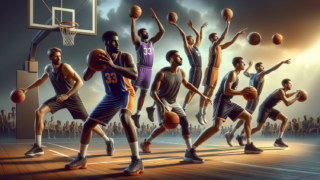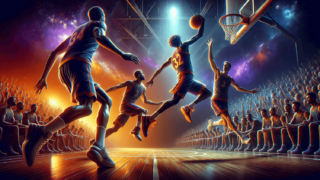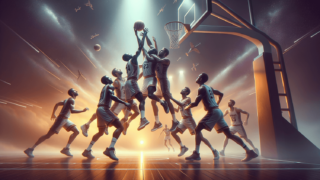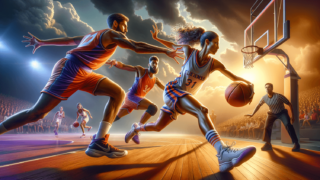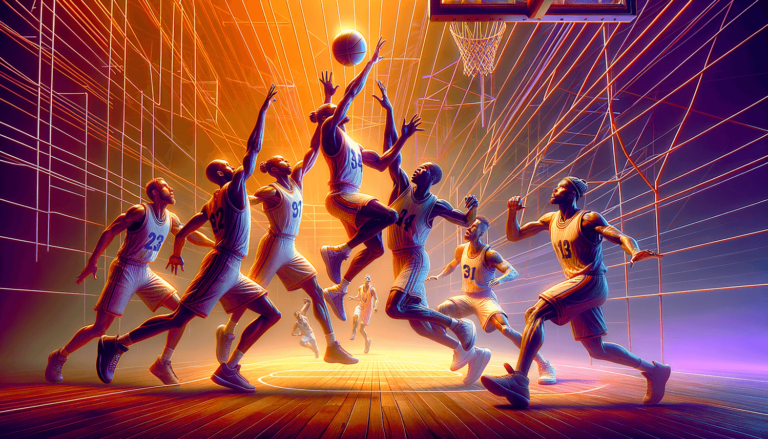
Grab your sneakers and get ready to dive into the thrilling world of basketball as we discover the art of the rebound! Nestled within the hustle and bustle of basketball lies one of the most critical yet often unsung elements of the game: the rebound. For those curious analytical minds thirsting for knowledge, this blog post will illuminate the term “rebound,” embarking on a captivating journey through its significance, techniques involved, and the difference it makes on the court. So whether you’re a seasoned basketball enthusiast or just beginning to explore this exhilarating sport, join us as we unlock the secrets of the rebound and appreciate this essential component of basketball mastery.
What Is a Rebound in Basketball?
A rebound in basketball occurs when a player successfully retrieves the ball after a missed field goal or free throw attempt. Securing rebounds is crucial as it can lead to extra possessions and scoring opportunities for the team, while also preventing the opposing team from getting additional chances to score. Rebounds can be classified as offensive (grabbed by the shooting team) or defensive (grabbed by the defending team).
Why Are Rebounds Important?
Before diving into the nitty-gritty of rebounds, let’s first understand their significance in the game of basketball. Rebounds are a game-changer because they give teams additional chances to score or regain possession, fostering intriguing twists and turns during matches. They are a true testament to a player’s skill, focus, and dedication, as snatching rebounds requires impeccable timing, athleticism, and anticipation.
The Art of the Offensive Rebound
In this section, we’ll explore the offensive rebound: a critical component of any team’s strategy. The offensive rebound offers teams an opportunity to recover their missed shots, retain possession, and potentially score more points. Mastery of offensive rebounding is essential to maintain pressure on the opponent and tilt the game’s momentum towards a team’s favor.
Boxing Out
As the cornerstone of an effective rebounding strategy, ‘boxing out’ is a technique used to gain better positioning during rebound attempts. Boxing out involves anticipating where the ball will land, positioning oneself correctly, and using one’s arms and body to create a secure zone to catch the ball. This critical move not only increases the chances of securing a rebound but also complicates the opponent’s efforts to do the same.
Crash the Boards
Also known as “crashing the boards,” this strategy involves the shooter’s teammates aggressively positioning themselves around the basket to retrieve a potential offensive rebound. It requires players to be aggressive, relentless, and lightning-fast, especially when pitted against strong defensive rebounders. Successful execution of this tactic can frustrate the opposing team, keep them on their toes, and increase the chances of scoring second-chance points.
Defensive Rebounding: Protect Your Territory
Defensive rebounding plays an equally significant role on the basketball court. Defensive rebounds prevent the opposing team from retrieving their missed shots, providing your team with an opportunity to regain possession and initiate a counterattack. Let’s go over some essential techniques to help you conquer the defensive rebounding domain.
Boxing Out (From a Defensive Perspective)
Just like offensive rebounding, boxing out is crucial for grabbing defensive rebounds. The primary objective here is the same: to claim better positioning to catch the ball while also obstructing the opponent’s path to it. Practicing this technique should be an essential part of any successful defensive rebounding strategy.
Team Communication
Effective communication is vital when securing defensive rebounds. Teammates should communicate their positions, notify each other of threats, and strategically coordinate to increase their chances of capturing the ball. Building a strong foundation of communication skills will not only elevate your team’s defensive rebounding prowess, but it will also strengthen team cohesion and unity throughout the game.
Rebounding Drills: Time to Practice!
Now that you’re familiar with the fundamentals of rebounding, it’s time to put theory into practice. To enhance your rebounding game, here are a few drills to sharpen your skills, strengthen your reflexes, and develop a mind-body connection to anticipate and capture those precious rebounds.
The Mikan Drill
Named after NBA Hall of Famer George Mikan, the Mikan Drill is an excellent exercise to practice finishing around the rim and improve rebounding skills. This routine usually consists of standing within arm’s length of the hoop, tapping the ball off the backboard, catching it, and doing so continuously while alternating hands. The Mikan Drill helps players concentrate, practice their timing, and develop good ball-handling habits around the net – all crucial when securing rebounds from opponents.
The Superman Drill
Designed to build agility and speed, the Superman Drill focuses on conditioning players to ‘fly’ across the paint, swiftly shifting their focus from offense to defense. This routine consists of sprinting from the baseline to the free-throw line, jumping to grab an imaginary rebound, and returning to the baseline to replicate the motion on the other side. This drill is an excellent way to prepare players for game scenarios where they have to cover both ends of the court to recover rebounds.
Tap and Reach Drill
This explosive drill aims to improve players’ reflexes, hand-eye coordination, and vertical leap to ensure maximum rebound grabbing efficiency. In this drill, players throw the ball off the backboard, jump to tap it back off the board, and return to the ground before performing another jump to secure the rebound firmly. The Tap and Reach Drill is an exemplary exercise to strengthen one’s rebound-catching instincts and get into the habit of capturing those high-flying balls.
Beyond the Numbers: Rebounding’s Unsung Heroes
Beyond the statistics and techniques, it’s essential to acknowledge the basketball legends whose names have become synonymous with exceptional rebounding skills. Historically renowned rebounders, like Dennis Rodman and Moses Malone, reinvented the term “crashing the boards” with their relentless pursuit of the ball. In today’s world of basketball, you can admire the rebounding prowess of superstars such as Kristaps Porzingis and Andre Drummond, constantly reminding us of the true impact of this crucial component on the game.
Rebounding Tips to Set You Apart
Armed with information about rebounds and the techniques to secure them, it’s time to gain a competitive edge with a few extra tips that will help you excel in this domain. Implement these simple yet effective suggestions into your game plan to stand out on the basketball court.
Stay Low and Wide
When positioning yourself to grab a rebound, make sure to stay low and wide. Adopting this stance allows you to maximize your area coverage, maintain stability, and keep a strong base for optimal balance.
Improve Your Anticipation Skills
Rebounding is not just about power and agility but also requires players to mentally anticipate where the ball will land. Focus on enhancing your game sense and try to predict the trajectory of various types of shots, increasing your chances of being in the right spot at the right time.
Develop a Strong More]]>
Master the Art of Positioning
Effective positioning is at the heart of mastering the art of rebounding. Analyze and understand players’ shooting patterns, and figure out the probable path of missed shots. This insight will allow you to align yourself in the optimal position to capitalize on rebounds. Study your opponents, identify their shooting tendencies, and use this knowledge to your advantage during the game.
Become an Ambidextrous Rebounder
Developing the ability to rebound effectively with both hands can give you an edge over your competition. Work on improving the strength and dexterity of your non-dominant hand, practicing rebounding drills that engage both sides of your body. Being an ambidextrous rebounder will make it much easier for you to react to the ball’s trajectory, regardless of which hand is closest or better-positioned to grab it.
Maintaining a Proper Stance
Having a sturdy, well-balanced stance is critical for successful rebounding. Maintain a low center of gravity with your knees slightly bent, ensuring that your feet are shoulder-width apart. This stance provides the stability to help you absorb contact from opponents, while also putting you in the perfect position to explode upward and grab that coveted rebound. Make sure to practice consistently to develop the muscle memory necessary to maintain this optimal stance.
The Role of the Guard in Rebounding
Rebounds are often associated with power forwards and centers, but guards play a crucial role in helping their teams secure the ball. Due to their speed and agility, guards can swoop in and retrieve loose balls or long rebounds, adding extra possessions and scoring opportunities for their teams. It’s vital for guards to collaborate with their teammates, ensuring that every player on the court is ready to contribute to the rebounding battle.
Managing Fatigue and Staying Energized
Basketball is a physically demanding sport, and rebounding can take its toll on a player’s energy levels. Nonetheless, staying energized and preserving stamina throughout the game is crucial for rebounding success. Implementing consistent conditioning exercises and maintaining proper nutrition and hydration can help you stay at peak performance levels. Additionally, learning when and how to pace yourself during the game will ensure that you remain focused and ready to grab those game-changing rebounds.
A Winning Mindset for Rebounding Success
Finally, it’s important to develop a winning mindset that embraces the challenges of rebounding. Cultivate mental toughness, resilience, and determination, learning to bounce back from mistakes and recognizing every missed shot as an opportunity to make a difference. Embrace the role of the unsung hero, recognizing that your efforts on the court, though not always measured in points or flashy moves, contribute significantly to the success of your team. Adopting this mindset will make you an indispensable part of any basketball lineup and turn you into a true rebounding powerhouse.
FAQ: Frequently Asked Questions About Rebounding in Basketball
If you’re looking to learn more about rebounding, we’ve compiled a comprehensive list of frequently asked questions to address common concerns, clarify misconceptions, and help you become an expert on this fundamental aspect of basketball. Scroll through these FAQs to discover valuable insights that will elevate your understanding of rebounds and their impact on the game.
1. What is the basic definition of a rebound in basketball?
A rebound occurs when a player successfully retrieves the ball after a missed field goal or free throw attempt. Rebounds can be classified as offensive (grabbed by the shooting team) or defensive (grabbed by the defending team).
2. How does rebounding contribute to a team’s success?
Rebounding is crucial as it can lead to extra possessions, additional scoring opportunities, and increased chances of winning. Offensive rebounds allow the shooting team to recover missed shots and maintain pressure on opponents, while defensive rebounds prevent the opposing team from retrieving their missed shots, letting your team regain possession and create counterattacks.
3. Are certain positions in basketball more likely to be good rebounders?
Power forwards and centers are traditionally known for being good rebounders, as they are generally taller and more physically dominant on both the offensive and defensive ends. However, skilled guards can also make a significant contribution to a team’s rebounding efforts.
4. How can I improve my rebounding skills?
Improve your rebounding skills by practicing boxing out, positioning, anticipating the ball’s trajectory, maintaining a proper stance, and regularly performing rebounding drills. Enhance your agility, strength, vertical jump, and overall conditioning to increase your chances of winning the rebounding battle.
5. What is the difference between an offensive rebound and a defensive rebound?
An offensive rebound is secured by the shooting team after their missed shot, allowing them to retain possession and potentially score more points. A defensive rebound, on the other hand, is grabbed by the defending team after the opposing team’s missed shot, preventing them from getting an additional chance to score.
6. What is the importance of boxing out in rebounding?
Boxing out is a technique that helps players gain better positioning for rebound attempts, using their bodies and arms to create a secure zone to catch the ball. This move not only increases the chances of securing a rebound but also impedes the opposing team’s ability to do so.
7. How does communication affect rebounding in basketball?
Effective communication helps players coordinate their positions, alert each other of threats, and strategize during rebound attempts. Proper communication skills facilitate better team cohesion and unity, increasing the chances of successfully capturing rebounds.
8. What are some popular rebounding drills?
Some popular rebounding drills include the Mikan Drill, the Superman Drill, and the Tap and Reach Drill. Each of these exercises is designed to improve a player’s timing, reflexes, positioning, and vertical leap to enhance rebound-grabbing efficiency.
9. Can an individual player’s rebounding skills improve their team’s overall performance?
Yes, a player that excels in rebounding can significantly enhance their team’s overall performance. Securing more rebounds translates into extra possessions, increased scoring opportunities, and a stronger defensive presence, all of which contribute to a team’s success.
10. Is anticipation important for grabbing rebounds?
Yes, anticipation plays a crucial role in successfully capturing rebounds. Players who can predict the trajectory of missed shots and assess where the ball is likely to land are better equipped to intercept and secure the ball for their team.
11. How can guards contribute to a team’s rebounding efforts?
Guards, with their speed and agility, can quickly recover loose balls or long rebounds, contributing significantly to their team’s rebounding efforts. Understanding and exploiting opponent’s weaknesses and collaborating effectively with teammates can make guards valuable assets in obtaining rebounds.
12. Are there any drawbacks to emphasizing offensive rebounding?
While offensive rebounding can generate extra possessions and scoring opportunities, it can also leave a team vulnerable on the defensive end. Committing too many players to offensive rebounding might lead to fewer players available to defend and handle fast breaks from the opposing team, creating a potential risk-reward scenario.
13. Who are some legendary rebounders in basketball history?
Famous rebounders in basketball history include Dennis Rodman, Moses Malone, Bill
Featured Posts
- No pillar pages found.
